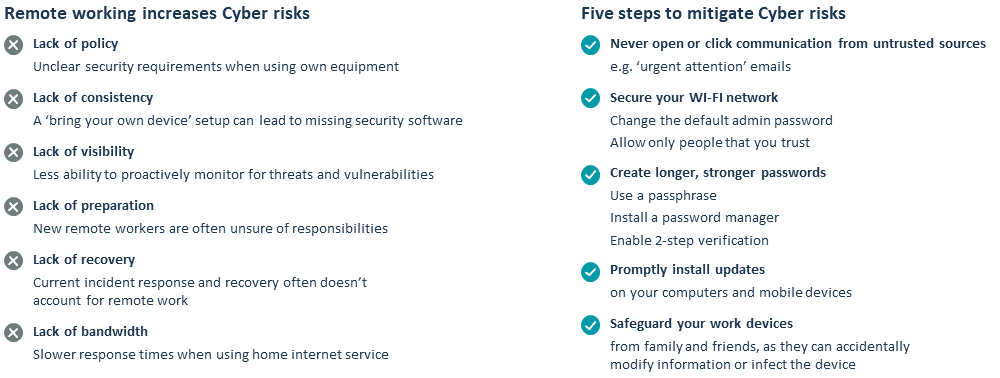The mining industry’s response to the COVID-19 pandemic has been noteworthy. By leveraging well-established crisis management skills, most miners have safely adapted their operations to protect the workforce while maintaining business operations. Many have seen skeleton crews deliver record results, as they focus on high-priority activities and avoid the distraction of non-critical projects.
However, COVID-19 also brought known gaps – in technology adoption, integration, and security – to the forefront. As miners ramp operations back up, the new norm of working remotely will add a further layer of complexity driven by the high number of ‘people on site’.
This presents an opportunity for mining companies to experiment with operating models they once thought impossible, including remote work teams for various functions (e.g. Human Resources, Planning) to minimise travel, resource requirements and logistics costs.

Be explicit about what is required – what, where and whom
Remote working at its worst allows inefficiencies, duplicates effort, fosters uncertainty and delays and causes low morale. Organisations can be slower to spot these issues as they arise because colleagues are often unable to meet and digital meetings require certain formality which is not required when you can simply stop in someone’s office to get things moving. In parallel, new ways of teamworking will emerge spontaneously and independently, driving both good and poor practice.
To address this, it is important to set clear expectations:
The new way things are done should be clearly defined and focus should be placed on driving high performance. To facilitate this, a new channel should be set up to allow clear communication with the frontline of daily, weekly, monthly targets and frequent daily touchpoints to identify and resolve issues quickly.
Is your organisation achieving alignment and ownership?
Establish a strong foundation for remote working with appropriate systems and tools
To be successful, new management operating routines should be clearly defined to create a shared view of desired outcome.
Clear accountability with supporting targets should be established and cascaded through the organisation – enabling all members of the highly dispersed workforce to pull in the same direction.

Keep your organisation cyber secure whilst enabling high performance
Working remotely introduces additional challenges around data and security. It is important to engage IT early in the process to find appropriate, sustainable solutions. IT plays a crucial role, as existing processes and policies can limit how quickly and effectively a team can access systems from outside the office.
Home networks are typically less secure than corporate networks, particularly when shared (e.g. multiple people working from home, children distance learning) – making your ‘human firewall’ critical in protecting the organisation from cyber threat.

In addition to mitigating cyber threat, organisations should ensure they have technology platforms in place that drive high performance. At present, a one-size-fits-all platform does not exist so do not rely on any single digital tool for every aspect of communication and collaboration. Each operation will need to experiment and figure out which digital tools work best for them. Some notable technologies that are driving improved performance, automated process control, machine learning to optimise set points, dashboards deployed to the frontline and remote integrated operating centres.
There is a vast array of online platforms available to enable communication (e.g. Skype, WhatsApp), information sharing and collaboration (e.g. Google Docs, Miro, Microsoft Teams) and project management (e.g. Trello, Monday.com, BaseCamp), as well as governance (e.g. Diligent, Boardvantage). This is an ideal opportunity to see how they will work within your organisation.
It is important to note that not all collaboration tools integrate nicely together, IT or cyber teams should have a holistic view of the tools being used to identify hidden cyber risks.
Change can be difficult and intimidating – build your team’s capability to use new solutions and deliver results.
If this is the first time using these platforms, help people familiarise themselves with how to use them. This could include training, either in groups or self-guided, or appointing ‘ambassadors’ to provide support within divisions or regions. With practice, these platforms will become just another part of your organisation’s toolkit and culture, enabling greater coordination and contribution.

Explicit norms should be established up front and should include regular live ‘catch ups’ to share progress, solve problems and communicate on specific topics. Set your remote team norms to maintain optimal collaboration and connection by locking in frequent communication to ensure alignment and reinforce best practice. Ensure real-time, ‘side-by-side’ coaching delivered through live contact (do not rely on emails). Exploit tools available, keep it casual and minimise adaptation required (exploit tools already in use).
Coaching and training can still be conducted effectively in a remote environment using a range of tools:
The pandemic forced mining companies to transition quickly into remote working. This presents an opportunity for organisations to transition into highly effective hybrid remote teams which build on the foundation of alignment and ownership, wiring, technology and capability.
This will deliver immense benefit to safety, productivity and costs. Organisations can achieve safer workplaces with less people on site. Productivity is increased both due to an expanded global talent pool (as remote lifts geographical restraints) and effective work from home practices. Both contributing to reduced overhead costs and increased profitability.

Richard manages our global Mining Practice. He has over 10 years’ experience across operational planning, engineering and leadership roles with a focus on business improvement, transformation and production optimization. He has performed several senior level mine planning and mine engineering roles in Australia, South East Asia and Latin America, and managed mining studies for major mining houses.
Click to download a printable version of this article
| We actively reduce the climate impact from our operations and invest in community-based climate solutions to balance remaining carbon emissions |